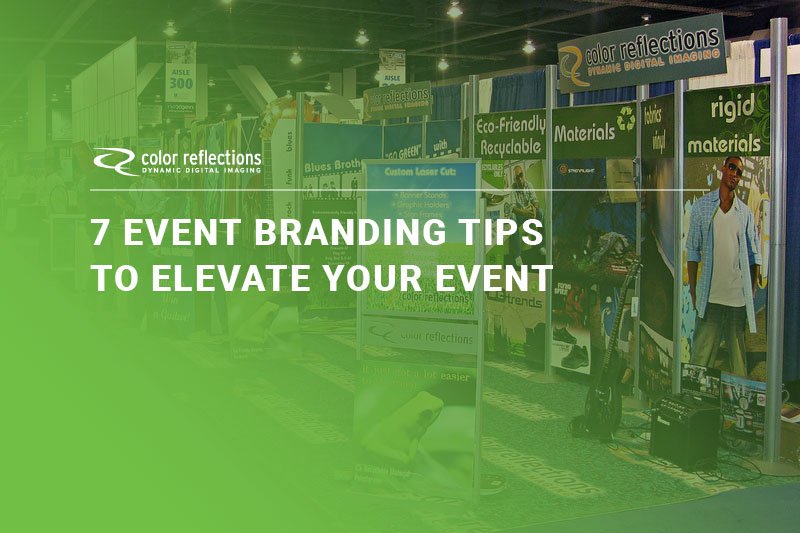You’ve been tasked with planning an event and you want it to be a success. You dream of creating the event of the year where attendees describe it as “not to be missed” and “unforgettable.” Your team has chosen a top-notch location, hired the best speakers, selected the finest foods, scheduled awe-inspiring entertainment, and considered every detail… all so your conference attendees enjoy every moment and head back to the “real world” filled with laughter and great memories.
Now, it’s time to market. You know who you’d like to get to your event, you’re just not entirely sure how to reach them and convince them not to miss out. No matter how good your event is, if you don’t get attendees flocking to your doors, you may not be planning this event in the future. You’ve got a bit of money in the advertising budget, but you’re not entirely sure where to start.
You’ve heard something about event branding but you’ve already got a logo. What more is there?
Want to make your next event’s brand truly stand out from the rest?
Grand format printing from Color Reflections get your event the attention you want.
What is Event Branding?
What is event branding? Much like branding for a business, event branding is not about how you want to be seen, but rather how your audience sees you. Successful branding marries the two so that the way your audience sees you is exactly how you’d like to be seen. And it’s never too early to start discussing your brand. From the moment you decide that an event will happen and put your team together, branding should enter the conversation.
When you hear about “branding” you may think that as long as you’ve got a logo and a color palette, you’re good to go. However, selecting the colors you’d like to work with and creating a logo is only one step in the branding process. In order to create a recognizable brand that triggers the “oh, that’s…!” reaction, you’ll need to consider much more. You’ll also want to switch it up a bit from your company’s brand so you create an event that can stand on its own. The event is related to your company, but it’s still a very different entity.
A strong event brand has many benefits such as:
- Stand out in an over-saturated marketplace. There are hundreds of thousands of events every year. Why should people attend yours over others?
- Give attendees a taste of what’s to come. Choosing the proper theme and tone for your event will allow attendees to get excited about what they are about to experience.
- Have every aspect of your event be recognizable. Let attendees know they are in the right room.
- Create an inclusive atmosphere. Attendees will feel as if they belong to something special.
Here are a few pointers to focus on as you create your event brand:
- Be Unique: You’ll want to make sure that your brand is unique to who you are and who your attendees are. This is the aspect that will set you apart from the competition and help you be recognizable.
- Be Purposeful: Make sure that the brand you choose serves a purpose and delivers what your attendees need and what you’ve promised.
- Be Authentic: Remember when we talked about your brand and how your customer sees you as opposed to how you want to be seen? If you declare your brand and then behave in a way that says otherwise, your integrity and honesty will be called into question and you’ll lose all credibility.
- Be Consistent: The most important aspect of branding is that you carry out the same visual and verbal message throughout the entire attendee experience. Creating a hodgepodge will detract from your message.
Now that you understand the importance of creating a brand and utilizing it throughout the event process, you’re probably wondering exactly how you do that. Every touch point with your customer, from the moment they first hear about your event, to the Thank You email they receive once it’s over, should take your brand into consideration.
Theme
Have you chosen a playful theme like “Wild West” or a business-related theme like “The Future of ___ Industry?” Your theme will be based on the purpose of your event as well as the tone you’d like to convey throughout it.
Fonts
Just like colors, different fonts create different associations in our mind. Don’t believe this? Think of the Disney font. How do you feel when you see other businesses using that font? It triggers a “something is wrong” signal in your brain, right? There are also some fonts that suggest whimsy and creativity while others convey a “nothing but business” attitude.
Image Styles
Photos and images can also elicit associations in our brain. Choosing a style that is consistent with your overall brand (and consistent with other images) will create a more unified experience. This can involve using black and white images, using a specific filter, and much more.
Tone
Take your ideal attendee into consideration as well as your goals for this event. Your tone should match the desired effect and should be carried throughout.
Taglines
Your theme will be further conveyed through the use of a tagline – a handful of words that tell attendees why they’re there and what they’ll experience.
Event Branding Tips to Promote Your Conference or Trade Show
Here are a few tips that will help you promote your event and make it special.
1. Start With Your Marketing
Whether you’re relying on word-of-mouth through social media or creating expensive advertisements and sizzle reels, your event brand should be present in every aspect of your marketing. If it’s going out into the world, it needs to be branded, whether it’s a flyer, invitation, program, or signage.
2. Consider Your Online Footprint
Branding isn’t just for printed marketing materials. Much of your attendees interaction with your event brand will be online and it should mirror the image they have of your brand in print. This includes your website, email invites, your registration portal, any social media you use, the event app that you create for attendees to stay up-to-date throughout the event, and more.
Make the online experience as user-friendly as possible. Web pages should be laid out clearly and calls to action (ex: Get Your Tickets Today) should be easy to follow. Thoroughly check the functionality of your site before releasing it to the world. The last thing you want is to see an influx of emails letting you know that your links don’t work.
3. Get Attendees Involved Early On
Create hashtags to start (and follow) the conversation online. You’ll want to have someone monitoring those hashtags as soon as they go live. This is what will allow you to make sure that the brand you’ve got is the brand you want. If you’re keeping a close eye, you’ll notice quickly if there is an issue brewing.
You can also create social media templates for attendees to share and let their friends or coworkers know they’ll bet attending.
4. Carry Your Branding Throughout The Decor
Just because they showed up at your event, doesn’t mean that they will be fully present, get the most out of the experience, or talk fondly of it afterwards. While the typical “promotion” period may be over, attendees will judge your event (and any future events you do) on what they see when they get there. Utilize your branding for signage, table cloths, decorative elements, photo backdrops, projections on walls, floors, tables, etc.
5. No Detail is Too Small
Branding isn’t just for the big aspects of an event. Items like napkins, giveaways in your swag bags, t-shirts, stickers, notebooks, and more can help enhance your image. Any event staff should have branded clothing that makes them seem like part of the event. Attendees can get branded lanyards or name badges, which make security easier to monitor and helps attendees recognize one another once they’ve stepped outside the event’s doors. You can even brand food and drink items. If you’ve got a theme, why not create a signature drink (maybe even an alcoholic and non-alcoholic version) for attendees. You could choose a clever name, select ingredients that will match your coloring, or garnish it with a logo swizzle stick.
6. Don’t Forget The Written Word
Branding includes the content on your marketing materials, website, social media, emails, and app. If the tone of your content doesn’t match the tone of your event and doesn’t speak to your intended audience, you’ll miss out on the benefits of branding.
Consider this scenario: You’re throwing a corporate gathering with a creative theme and a bright, colorful, and eclectic design. You’ll fill the time between sessions with interactive games that have your attendees tapping into their inner-child. However, when you go to write the copy for your marketing, the verbiage is dry, dull, and filled with corporate-speak. You’re sending mixed messages to your audience which are bound to confuse and deter them. Match the tone of your words with the tone of your event.
7. Follow Through to the Follow Up
Whether you send a questionnaire asking for feedback and suggestions on how to make the event better in the future, or just a simple Thank You for attending and being a part of this special occasion, don’t fall apart before the Follow Up. Anything you send to attendees after an event should have the event branding throughout. Stay consistent and you’ll reinforce the memories your attendees had while leaving them with a good last impression. This is especially important if you plan on hosting the event again of if you want to keep in touch with your attendees.
While you may not have originally factored a branding line into your event budget, creating one can make your event more successful. You’re going to spend a lot of time and energy organizing your event, meaning it only makes sense to do this last step. By building a strong, distinctive event brand, you can build a stronger connection with attendees, making your event more memorable and effective at promoting your business.

